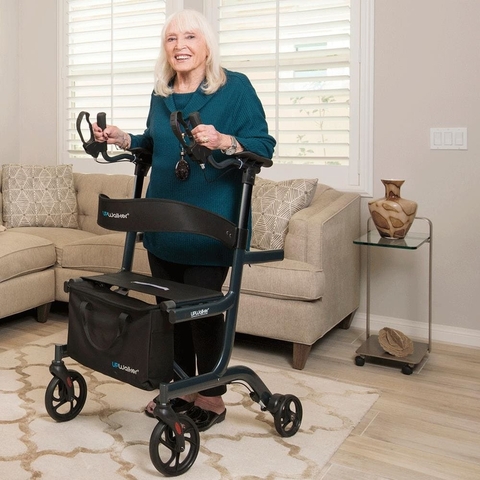
The elderly, especially those with osteoarthritis and other musculoskeletal issues and many other patients after a stroke, may need walkers to maintain balance, reduce the range of motion, and support themselves while navigating. Suppose you pick the best walker; consider your individual needs since there are many options. Learn how to safely and effectively use a walker, as improper walker use can cause falls.
Walker can be an excellent assistive device when a person is recovering from an injury or illness that leaves them weak. Walkers allow the user to move around easily. Let us look at what steps to follow to use a walker properly. Learn how to use a tall stand-up walker safely. Start by placing the walker a few inches before you and then stepping back into it. The walker should never be used to pull you out of a sitting position. You should also never lean on it entirely.
Start With the Right Model
From simple to deluxe, there are different types of walkers. Wheel sizes are available for some lightweight devices, while others come with wheels, seats, hand brakes, and other features. Occupational therapists and physical therapists can determine which model is suitable for you. A walking frame can be bought online or at a medical supply store.
Walking With Your Walkers
You can start by pushing the walker forward and then stepping into it. Continue this pattern -- step into the walker and then walk slightly ahead. You must never stray too far ahead of your walker and always maintain a good posture when stepping.
Likewise, look in front of you rather than down at your feet. It may be better to use a platform walker if you have trouble gripping it. This platform relieves the stress on your hands by allowing your elbow and forearm to rest.
You must stand inside the walker and keep all four wheels touching the ground before moving. In other words, when walking on the walker, your hips should be aligned with the leg nearest to you. If the front of the walker is so close to you that you can't take a good step forward, it shouldn't look like you are pushing the walker in front of you.
When using the tall stand-up UPWalker, your belly should always face the front. Rather than doing a twist with your walker while holding it in the air, keep the walker in front of you and take small steps when you want to turn! If you fall or lose your balance, it's better to have a walker close by.
Safe and Best Walker Use for Seniors
As a first step, a walker must be used safely and effectively to maximize the practical use value and reduce trips or falls. It will either be lifted or pushed forward by the elder leaning on the walker. It will require the user to exert some muscular strength through their arms.
It would be best not to use a walker to get up from a seated position, as it will cause tilt and loss of balance. Alternatively, lift yourself from the chair by using your arms and put your hands on the walker only after you have almost entirely stood up.
Add padding like these to the handles to make the walker's handles comfortable. Sit down by holding the walker with one hand and reaching for the chair arm with the other. Put one hand on one arm of the chair and the other on the walker. Once you have a grip on that, release the walker.
Never use the walker simultaneously as you are carrying items in your hands. Alternatively, you may want to use a Walker Bag or wear a fanny pack with your walker. When choosing a walker, ensure it will support 50% of your weight - this is your leaning weight. The older adult should not apply a full body weight on the up walker ( these walkers are not designed for that purpose). Use a Bariatric Walker if your weight limit exceeds the standard weight limit.
Avoid rough surfaces and rugs in your pathway that could cause the feet of the walker to get entangled. Generally, rolling walkers can navigate these surfaces without any difficulty. Walk away from electrical cords, objects, and other things you may trip over with a walker.
Unlike some rolling walkers, a standard walker generally does not come equipped with walker accessories like trays or bags. Suppose your elderly loved one is qualified to place items in an attached pouch much more accessible than carrying that item with a walker. When using a walker with a seat, ensure that the brakes are engaged before sitting on it.
Where To Get A Walker?
A walker is considered Durable Medical Equipment (DME); therefore, Sky Medical Supplies will provide a walker at a reasonable cost. You can also buy a walker from your local medical supply store.
Final thoughts
An appropriate walker prevents you from falling and injuring yourself and enables you to remain as independent as possible. Your mobility is significantly enhanced by using the right walker. Ensure you know how to use one safely and adequately before stepping out, and always consult with a physical therapist before choosing one. Sky Medical Supplies can provide the best walker to fulfill your needs. If you live near Denver, Colorado, Visit Sky Medical Supplies at our store close to the Denver international airport (DIA) to find a wide range of walkers to choose the best one for you or your loved ones. If you can make it to the shop, you can visit the online store. You will find a lot of alternatives to choose from. Also, if you prefer to rent than buy, you are also in good hands at Sky Medical Supplies! Choose from the available rentals that suits you the best!